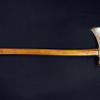Relatives/Heritage items
Displaying 2561 - 2580 of 4694 Relatives
Browsing allows you to see all the records for relatives and heritage items in the GKS. You can also search by material made, and/or filter by nations. To search by material made, type the material's name, by example 'leather', in the box below and click “Apply.” You can select multiple nations from the dropdown list by pressing “Ctrl” (on PC) or “Command” (on Mac) and clicking, then select “Apply.”
Waugh Collection Photograph
Waugh Collection Photograph
Waugh Collection Photograph
A single loom beaded garter of cotton yarn and multicoloured seed beads, ends of attached red wool yarn fringes are twisted togther; obtained from the Menomini, Wisconsin and purchased from William Jones. [Almost identical with EMB IV-B-6444, only colors reversed]
Waugh Collection Photograph
Waugh Collection Photograph
Waugh Collection Photograph
[F. W. Waugh's notebook on Haudenosaunee (Iroquois) dwellings and customs; Fieldnotes. 64 pages : handwritten, with drawings. CMC Control No. E200-9.1.001-E200-9.1.064. his information was obtained from John Jamieson, a Gayogho:no (Cayuga) and John Echo, an Onodagehono (Onondaga) from Grand River Reserve [Six Nations Indian Reserve
This is also a test.
A Dictionary of the Otchipwe Language
Explained in English
Part I
English-Otchipwe
By R. R. Bishop Baraga
Strap dress made of blue stroud with colourful ribbonwork appliqué and yellow tube beads; shoulder and collar straps are black velvet with floral beadwork. Part of a set with sleeves collected by Frances Densmore.
Sleeves of blue stroud with multicoloured ribbonwork, with cuffs of black velvet with floral beadwork. Part of set with strap dress collected by Frances Densmore.
An unsmoked hide knife sheath decorated with quillwork and beaded tassels. Although the origins of this relative are not certain, it has probable connections to the Anishinaabe or Haudenosaunee/Hodeonsaunee and was likely made in the 18th century. This item is part of a collection donated
A pipe tomahawk with a cast metal bowl and a wooden stem. A motif incised on the blade's centre top, that looks like a slanted ladder with four bars between two parallel lines, may be a maker's mark or stamp. Late 18th to 19th century
 Knowledge Sharing Platform
Knowledge Sharing Platform
















